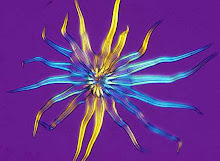After a lifetime as a professional scientist, I have to admit that scientific research papers constitute one of the most tedious forms of literature ever devised. The science might be exciting but the words are usually unspeakably dull. That isn't just my opinion .... here's what Nobel laureate Francis Crick, co-discoverer of the structure of the DNA molecule, had to say about the matter:
“There is no form of prose more difficult to understand and
more tedious to read than the average scientific paper”.
Francis Crick. 1994. The Astonishing Hypothesis
But it wasn't always this way.
This is a line illustration of the dung fungus Pilobolus, taken from this research paper:
W.B. Grove (1884) On the Pilobolidae, with a synopsis of the European species, and a description of a new one. Paper read at a meeting of the Birmingham Natural History and Microscopical society, 17th. April 1883.
They say a picture is worth a thousand words, but in this case I much prefer a thousand words because I have never read a scientific publication that so vividly conveys the author's sheer delight at a discovery.
Here is his description of the fungus (bear in mind that in Grove's day scientific papers like this were routinely read aloud to an audience. For fullest effect stand tall, preferably in evening dress, and read it aloud while grasping your lapels or making extravagant gestures. Reading scientific papers was performance art in those days)
"Imagine an oval translucent vase of exquisite outline, carved from a
single diamond, not indeed of the finest water, but brought from South African
Fields, tinged with a delicate yellow colour. Place beneath this a gracefully
curved slender stem, of crystal clear, and where they join let a circlet of the
purest gold lie coiled within the tube. Then let a beautiful and limpid light
radiate from every part. To enhance its effect, take a piece of blackest jet,
shaped into a perfect hemisphere. Polish its surface until it shines like a
Venetian mirror, and gently poise this sooty crown over the mouth of the
transparent vase. Let glistening strings of orient pearls hang around in
graceful festoons, and imagine the whole of this priceless work reduced in size
till the total height exceeds not a twentieth of an inch. To complete the
contrast, thickly strew these fairy jewels over the half-dried surface of a
cake of cow dung, and you have imitated nature as far as your powers allow. To
mortals this treasure is known by the name Pilobolus,
and the particular species I have pictured is called Pilobolus kleinii."
Click here for a movie of Pilobolus and click here for a photograph and information and you'll see why he found it so beautiful.
"Once, when I was examining a tuft with a lens I heard a faint
sound proceeding from another tuft six inches off, and at the same instant felt
myself struck near the middle of the forehead; the blow was accompanied by a
sensation as if a tiny drop of water had fallen there. On looking in a glass I could see a little black sporange [sic] adhering where it struck, and it
remained there for several hours. I immediately took the patch of P.kleinii from which it came (and I
should mention that the stems of these specimens were bent almost at a right
angle under the influence of the one-sided light beneath which they had grown)
into an empty room, where I placed it with the upper portions of the bent stems
pointing towards the window. I then laid a number of sheets of white paper
around it, in the same horizontal plane; carefully closed the door and left it
for an hour. This was just about midday. On returning I found all the sheets
covered with a multitude of black dots, which a lens revealed to be the
sporangia; each sporangium was surrounded by a brownish stain, produced by the
liquid ejected at the same time. On measuring the distances to which the
sporangia were thrown I found that a majority lay between three and four feet,
but nearly a score lay at a greater distance than four feet, and the farthest
that I could find at a distance of 4ft. 10in. When we consider that the utmost
height of the individual fungi from which these bomb-shells proceeded did not exceed
one tenth of an inch, and that therefore the last mentioned sporangium was
thrown to a distance of nearly 600 times the height of the plant which threw
it, we can form some idea of the enormous force exerted in this instance. It is
as if a man of average height were able to throw his own head to a distance of
nearly two thirds of a mile."
As I say, they don't write 'em like that anymore. I rest my case.
























That was a very good read, I hate to think how people manage to find anything of interest nowadays.
ReplyDeleteLess romatically, I thought it was an illustration of a tapeworm
ReplyDeleteIf it meant reading papers of this eloquence, Phil, I reckon there'd be a lot more scientists on the planet! This presupposes, however, that there'd be a supply of scientists able to write to such standards - so, considering the 'youf' of today, the theory probably falls doown there !!
ReplyDeleteHave a great Christmas, and best wishes for 2016 - - - Richard
All the best to you too, Richard!
Delete